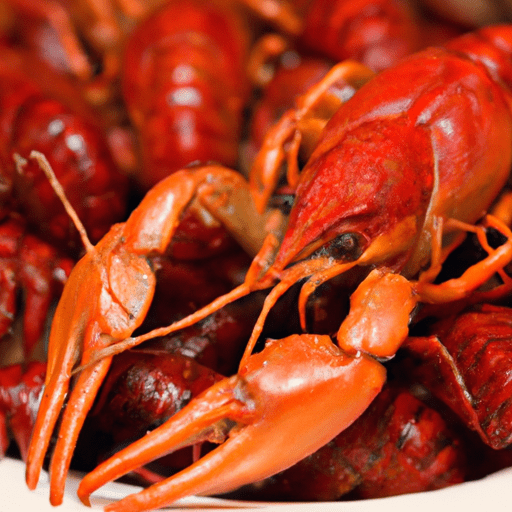The Crayfish: A Delicacy from Freshwater
If you are a seafood lover, then you’ll definitely want to dive into the world of crayfish. Also known as crawfish or freshwater lobsters, these small crustaceans pack a punch of flavor and are a popular delicacy in many cuisines around the world. In this blog post, we will explore the taste, culinary uses, nutritional value, and share some interesting facts about these delectable creatures.
Taste Sensation
Crayfish have a unique flavor that can be described as a cross between lobster and shrimp. Their meat is tender, succulent, and slightly sweet, which makes them a real treat to savor. When cooked properly, crayfish offer a delicate texture and a delightful taste that will leave you craving for more.
Versatile Culinary Uses
Crayfish are extremely versatile and can be used in a variety of culinary preparations. They are commonly used in soups, stews, bisques, and pasta dishes, adding depth and complexity to the flavors. These little crustaceans are often the star of Cajun and Creole cuisine, where they are featured in iconic dishes like crayfish étouffée and crayfish boil.
If you’re feeling adventurous, try incorporating crayfish into risotto, salads, omelets, or even as toppings for pizzas and savory tarts. Their flavor pairs well with garlic, butter, lemon, and a range of aromatic herbs and spices. The possibilities are truly endless when it comes to cooking with crayfish.
Nutritional Value
Apart from their delicious taste, crayfish also offer a good dose of nutrition. They are packed with high-quality protein, essential vitamins, and minerals. These little creatures are a great source of B vitamins such as niacin, B6, and B12. They also contain important minerals like calcium, iron, zinc, and potassium. Moreover, crayfish are low in fat and carbohydrates, making them a healthier choice compared to some other protein sources.
Rich History and Fascinating Facts
Crayfish have a rich history that dates back centuries. They have been enjoyed as food for generations, particularly in regions with abundant freshwater sources. Native to Europe, North America, Australia, and parts of Asia, crayfish have become an integral part of many regional cuisines.
Did you know that Louisiana produces over 90% of the crayfish in the United States? In fact, it is the largest supplier of crayfish in the world. Every year, the state hosts numerous crayfish festivals celebrating the culinary heritage of these little crustaceans. It’s a testament to their popularity and significance in the vibrant Louisiana food culture.
It’s important to note that crayfish are also crucial to the ecological balance of freshwater ecosystems. They contribute to maintaining water quality and serve as an essential part of the food chain.
Sustainable Sourcing and Preparation Tips
When it comes to sourcing crayfish, it’s advisable to opt for sustainably harvested or farmed options. This ensures the preservation of the species and the health of their natural habitats. Always check the origin and ensure that the crayfish are sourced responsibly.
Before cooking crayfish, make sure to clean them thoroughly by removing any dirt or sand. You can then boil or steam them for a few minutes until they turn bright red. Be sure not to overcook them, as it may result in tough and rubbery meat.
Time to Indulge!
Now that you know more about crayfish, it’s time to head to your nearest seafood market or order online and embark on a culinary adventure. Experiment with different recipes, enjoy the delicious flavors, and appreciate the rich heritage behind these delightful creatures. Whether you’re hosting a summer gathering or craving a decadent seafood dinner at home, crayfish are sure to bring a touch of gourmet delight to your plate.
Bon appétit!
Origin:
- Crayfish, also known as crawfish, langoustine, or freshwater lobsters, belong to the family Astacoidea and are omnivorous crustaceans.
- They are found in freshwater habitats, such as lakes, rivers, streams, and ponds.
- Crayfish are native to North America, particularly the southeastern United States, where they are a popular culinary ingredient.
Common Uses:
- Crayfish are highly valued in culinary traditions around the world, often used in dishes that highlight their sweet and delicate meat.
- They are commonly used in seafood boils, stews, bisques, and stir-fries.
- Crayfish tails are also used as a topping for pastas, salads, and as a filling for sandwiches and po’boys.
- In some regions, crayfish are used to flavor stocks and sauces to add depth and richness to dishes.
Nutritional Benefits:
- Crayfish are a low-fat source of high-quality protein, making them a good addition to a balanced diet.
- They are also a good source of vitamins and minerals, including vitamin B12, phosphorus, selenium, and copper.
- Crayfish contain Omega-3 fatty acids, known for their heart health benefits.
- However, it’s important to note that the nutritional content may vary depending on the cooking method and any added ingredients.
Unique Properties and Historical Significance:
- Crayfish have a hard exoskeleton, segmented body, and two large pincers.
- They are known for their ability to regenerate lost limbs, which gives them a unique resilience.
- Crayfish have a complex mating ritual, where males court the females by waving their pincers and creating vibrating sounds using their legs.
- Crayfish trapping and consumption have historical significance in Louisiana, where it has become an important cultural symbol and part of traditional cuisine, particularly during the annual Cajun and Creole crawfish boils.
- Some species of crayfish have been introduced to non-native habitats around the world, where they have become invasive and negatively impacted the local environment.




Use the share button below if you liked it.
It makes me smile, when I see it.